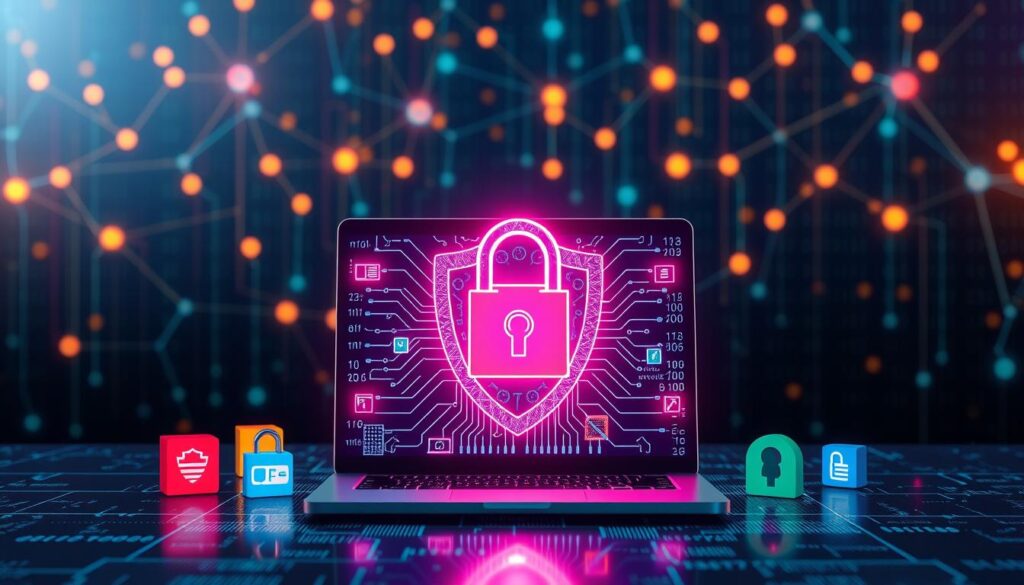Cybersecurity is key in today’s digital world. It’s vital for both individuals and businesses to protect their online data. The cost of cybercrime is set to hit $6 trillion by 2023. The average data breach costs around $3.92 million.
This shows how important it is to have strong cybersecurity. This includes protecting data and securing networks to avoid breaches.
Small and local government agencies should follow CISA’s Cyber Essentials guide. It helps them get ready for cyber threats. A Culture of Cyber Readiness has six key parts. It stresses the role of leaders in setting up a strong cybersecurity plan.
It’s also important to keep staff updated and trained. This helps them stay alert to risks like phishing.
Organizations should keep track of their hardware and software. This helps them know what’s at risk from attacks. About 60% of breaches happen because of unpatched vulnerabilities.
Using multi-factor authentication is a good idea. It can stop up to 99.9% of automated attacks. It’s also smart to back up data regularly. Studies show that 30% of companies don’t back up their data at all.
Key Takeaways
- Implementing robust cybersecurity measures is essential to prevent data breaches
- Data protection and network security are critical components of cybersecurity
- Regular updates and training are necessary to maintain cybersecurity awareness and vigilance
- Multi-factor authentication can block up to 99.9% of automated attacks
- Establishing regular automated backups is crucial to prevent data loss
- Cybersecurity training can reduce the likelihood of a data breach by 75%
Understanding Modern Cybersecurity Threats
Cybersecurity threats are always changing. Every year, more attacks happen. It takes 150 days to find out about a breach. This shows we need strong internet security.
Information security is key to fight these threats. These threats can cause big financial losses and harm a company’s reputation.
Common cyber attacks include phishing, malware, and ransomware. These attacks can be very harmful. For example, the WannaCry ransomware attack in 2017 hit over 200,000 computers in 150 countries.
New threats like AI-powered attacks are also rising. It’s important for companies to keep up with these threats.
Common Types of Cyber Attacks
- Phishing attacks: 90% of data breaches start with phishing.
- Malware attacks: Malware causes 90% of cyberattacks.
- Ransomware attacks: Ransomware attacks have jumped by 300% in the last year.
Emerging Threat Landscapes
APTs and AI-powered attacks are becoming more common. Companies need strong information security to fight these threats.
Impact of Cyber Attacks on Individuals and Businesses
Cyber attacks can have a big impact. The average cost of a data breach is $4.45 million. Companies must focus on cybersecurity to protect against threats and avoid big losses.
The Fundamentals of Data Protection
Data protection is key in cybersecurity. There are many ways to keep online data safe. Using cybersecurity solutions can stop data breaches and keep information safe. In 2021, a data breach cost about $4.24 million on average, showing how important it is.
Important data protection steps include encryption, backups, and access control. Encryption guards data in transit and at rest. Backups help get data back after disasters or cyber attacks. Access control limits who sees sensitive data, lowering breach risks.
Companies can use cybersecurity solutions like firewalls and antivirus software. Training employees also helps avoid data breaches caused by mistakes. These steps help keep data safe and avoid expensive breaches.
Good data protection lowers breach risks, meets rules, and builds customer trust. By focusing on cybersecurity solutions and strong cybersecurity measures, companies can keep their data secure.
Essential Cybersecurity Tools and Software
Cybersecurity tools are key to keeping online data safe from threats. To protect well, you need a mix of tools and software. Important ones include antivirus, firewalls, VPNs, and password managers.
These tools help fight malware, block unwanted network access, and encrypt data. For instance, antivirus software finds and removes malware. Firewalls block unauthorized network access.
- Antivirus and malware protection: behavior-based detection, sandboxing, and signature-based detection
- Firewall solutions: packet filter, connection tracking, and application/layer 7
- Virtual Private Networks (VPNs): encryption of internet traffic and protection of data in transit
- Password managers: generation and storage of unique, complex passwords
Using these tools, people and businesses can safeguard their online data. It’s crucial to pick the right tools for effective protection.
Creating Strong Authentication Protocols
Creating strong authentication protocols is key to cybersecurity best practices. It helps keep online data safe from unauthorized access. Recent stats show that 63% of data breaches happen because of weak or stolen passwords. This shows the importance of strong cybersecurity measures.
Organizations that use multi-factor authentication can cut data breach risks by up to 99.9%. This proves how effective this information security method is.
To make strong authentication protocols, organizations can mix different methods. For example:
- Multi-factor authentication, which asks for more than one form of verification
- Biometric authentication, like fingerprint or facial recognition
- Physical security keys, which can stop phishing attacks
By following these cybersecurity best practices, organizations can greatly lower data breach risks. As cybersecurity measures keep changing, it’s vital for organizations to keep up with the latest information security trends and technologies. This ensures the safety of their online data.
Securing Your Home Network
To keep your home network safe from cyber threats, you need strong security steps. Make sure all your devices and software are updated. This includes your router and internet security tools.
Using WPA3 or WPA2 encryption with a strong password helps a lot. It makes it hard for hackers to get into your network. Regular updates are key to fixing security holes.
It’s smart to update IoT devices every month, even if they don’t update automatically. Using cybersecurity solutions like layered defense software helps fight malware. These steps can greatly lower the chance of cyber attacks.
- Changing default passwords and enabling WPA2 encryption
- Setting up a guest network to reduce the risk of unauthorized access
- Using a virtual private network (VPN) to secure communications
- Regularly updating router firmware and IoT devices
- Implementing network segmentation to separate primary Wi-Fi, guest Wi-Fi, and IoT networks
By taking these steps, you can make your home network safe from cyber threats. Always use strong, unique passwords. And keep your devices and software up to date to avoid cyber attacks.
Best Practices for Safe Internet Browsing
Safe internet browsing is key to protecting your online data. There are many best practices to follow. Avoiding suspicious links and using antivirus software can stop malware infections. Strong passwords also help prevent cybercrime.
Recent stats show that nearly 80% of data breaches are due to weak passwords. This shows how crucial cybersecurity best practices are for internet security.
To keep your information secure, make sure your web browser is always updated. Up to 90% of cyberattacks use known software vulnerabilities. Using Two-Factor Authentication (2FA) can block up to 99.9% of account hacks.
Many users (about 36%) don’t clear their browser cookies regularly. This can lead to tracking and targeted ads. By following these best practices, you can greatly lower your risk of cybercrime.

- Using a reputable antivirus software
- Avoiding suspicious links and emails
- Implementing strong, unique passwords
- Enabling Two-Factor Authentication (2FA)
- Regularly clearing browser cookies
By following these tips and staying updated on cybersecurity best practices, you can protect your online data. This will help you avoid falling victim to cybercrime.
Mobile Device Security Measures
Mobile devices are becoming more common, and so is the need for strong cybersecurity. It’s important to protect against malware and unauthorized access. Using tools like encryption and secure login methods helps a lot.
Keeping your mobile device safe is key. Always update your operating system and use strong passwords or biometric locks. Be careful with public Wi-Fi and don’t download apps from unknown sources. These steps help keep your data safe from cyber threats.
- Enabling encryption to protect sensitive data
- Using a secure connection when accessing the internet
- Implementing two-factor authentication to add an extra layer of security
- Regularly updating operating systems and apps to patch vulnerabilities
By following these tips and using good cybersecurity tools, you can lower the risk of security breaches. This keeps your mobile devices safe from many threats.
Cloud Storage Security Guidelines
Keeping your online data safe is key in cloud storage security. There are steps you can take to protect your data, like using encryption and managing access. It’s best to encrypt your data both when it’s stored and when it’s being moved, using approved methods.
Using Role-Based Access Control (RBAC) and Attribute-Based Access Control (ABAC) can help limit who can access your data. This makes your information safer. Cloud providers also offer Key Management Services (KMS) for secure key storage and generation. This lets you use your own keys if you want.
To make your cloud storage even safer, use Data Loss Prevention (DLP) systems. These systems help find and manage data exposure. Regular checks of your cloud resources are also important to catch any issues.
By following these steps and using good cybersecurity, you can keep your cloud storage data safe and secure.
Social Engineering and Phishing Prevention
As cybersecurity threats grow, protecting your internet security is key. Phishing attacks rose by 50% from 2018 to 2020. To fight back, using cybersecurity best practices is crucial. For example, regular phishing tests can cut down on attacks by 40%.
Here are some ways to stop social engineering and phishing:
- Implementing multi-factor authentication to block automated attacks
- Providing regular employee training on identifying phishing attempts
- Using email security solutions to block phishing emails
By focusing on cybersecurity threats and using strong internet security methods, you can lower the risk of attacks. In 2020, the average data breach cost was $3.86 million, with phishing being a big reason. Following cybersecurity best practices helps protect your business and team from these dangers.

Data Backup and Recovery Strategies
Protecting online data is key. It means using strong cybersecurity solutions and measures. Up to 30% of computers in the U.S. have malware, which can harm data.
A good data backup plan is vital. The 3-2-1 strategy is recommended. It means having three data copies, using two storage types, and one offsite copy. This keeps data safe from disasters and cyber attacks. Continuous Data Protection (CDP) also helps by saving data changes automatically.
Backup Methods and Tools
There are many backup options like external hard drives, cloud storage, and software. Daily or weekly backups are best for those with important data. It’s also key to test backup systems often. Some companies only test theirs once a year.
Recovery Plan Development
A solid recovery plan is crucial. It should cover restoring data and getting business back on track. Companies like TBC offer IT solutions for backup and recovery at a fixed cost.
Strong cybersecurity and data protection strategies are essential. They help prevent data loss and ensure business keeps running. It’s important to keep backup and recovery plans up to date.
Conclusion: Building a Robust Cybersecurity Framework
In today’s digital world, keeping your online data safe is key. A strong cybersecurity framework helps a lot. Studies show that using good cybersecurity can cut data breach risks by up to 50%.
As threats grow, knowing the latest security tips is vital. Training employees, using top security standards, and being ready for attacks are important. These steps help businesses keep their data safe and earn customer trust.

